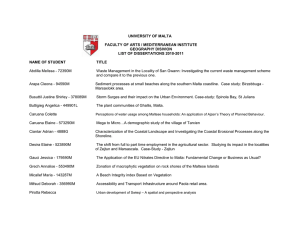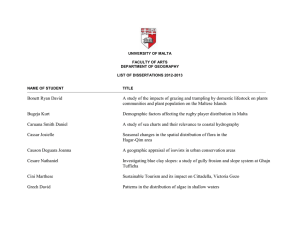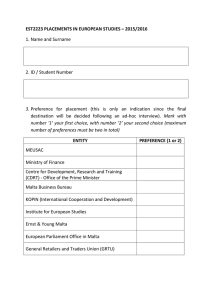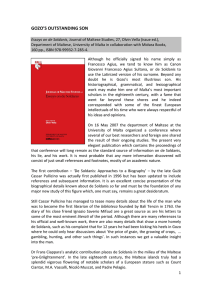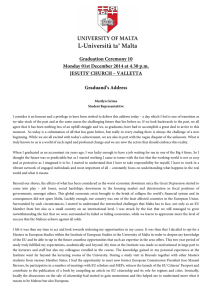FHS Monthly Newsletter: October 2012 RESARCH, PUBLICATIONS & PRESENTATIONS
advertisement
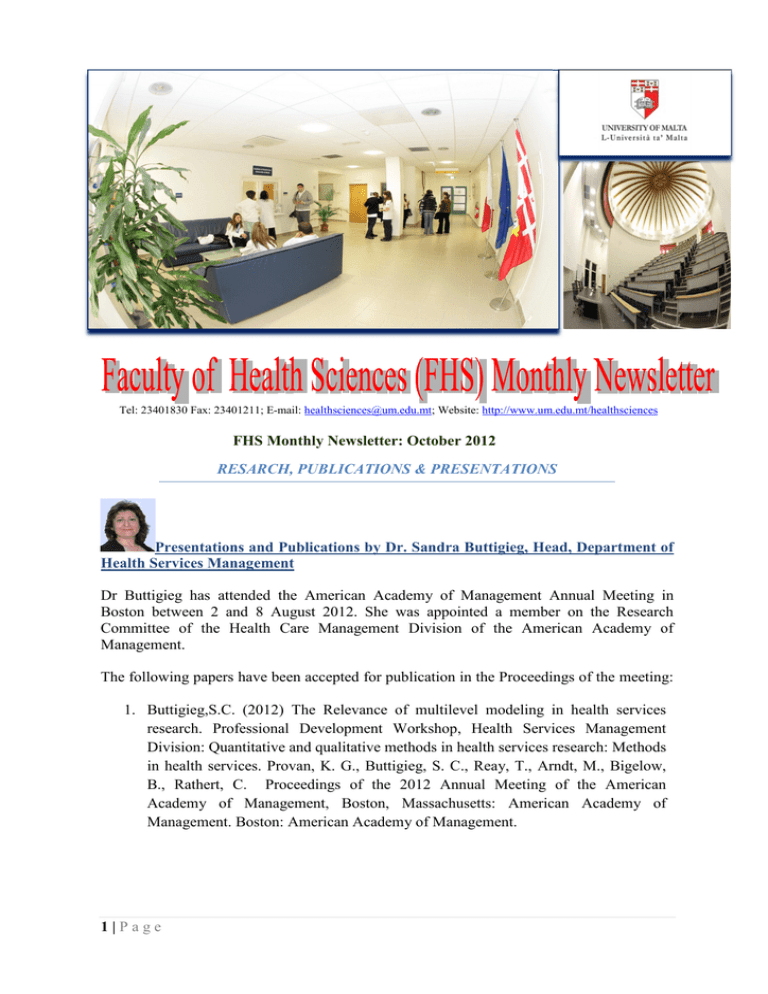
Tel: 23401830 Fax: 23401211; E-mail: healthsciences@um.edu.mt; Website: http://www.um.edu.mt/healthsciences FHS Monthly Newsletter: October 2012 RESARCH, PUBLICATIONS & PRESENTATIONS Presentations and Publications by Dr. Sandra Buttigieg, Head, Department of Health Services Management Dr Buttigieg has attended the American Academy of Management Annual Meeting in Boston between 2 and 8 August 2012. She was appointed a member on the Research Committee of the Health Care Management Division of the American Academy of Management. The following papers have been accepted for publication in the Proceedings of the meeting: Dr two papers which were subsequently published in the Proceedings as full papers: 1. Buttigieg,S.C. (2012) The Relevance of multilevel modeling in health services research. Professional Development Workshop, Health Services Management Division: Quantitative and qualitative methods in health services research: Methods in health services. Provan, K. G., Buttigieg, S. C., Reay, T., Arndt, M., Bigelow, B., Rathert, C. Proceedings of the 2012 Annual Meeting of the American Academy of Management, Boston, Massachusetts: American Academy of Management. Boston: American Academy of Management. 1|Page ABSTRACT: Over the years, there has been a growing interest in defining constructs at multiple levels starting mainly in educational, sociological and psychological research. This PDW considers the relevance and application of multilevel modeling, also known as hierarchical linear modeling, as a major analytical strategy to address hierarchical data in health services research. Specifically, multilevel models are statistical techniques that elucidate the importance of contextual effects as these relate to individual level health, disease, social, psychological and demographic factors. Additionally, these models help us to understand health outcomes, behavior and service performance. To assist us in understanding the structure and potential of these techniques, this PDW provides an introduction to multilevel modeling, the rationale for using these techniques, and examples of published literature, highlighting its applications. This PDW will also attempt to emphasize that as statistical techniques, they assist us in avoiding the violation of the assumptions inherent in the use of ordinary least squares, namely independence of observations, and homoscedasticity. The majority of simple regression methods assume independence of observations on which the regression is performed. In health care-related research, as well as in many other fields, this assumption is theoretically violated in a wide range of situations. For example, in longitudinal studies, there are repeated measurements across time, nested within individuals. Additionally, participants may be nested within families or geographical units, within physicians' offices, or within hospitals, and patients in multi-centre clinical trials are nested within study centers. In accounting for the clustering effects of individual observations nested in higher level units, multilevel models provide us with more accurate statistics, and therefore enable us to reach more meaningful results, conclusions and recommendations. Multilevel models have become more popular as a result of the growth of computing power and availability of software. 2. Buttigieg, S. C., Guillaume, Y. R. F. (2012), Asymmetric curvilinear effects of gender dissimilarity on work productivity. Symposium: 20 years of relational demography research: Current challenges and future research directions. Relational Demography Research. Chair: Yves R. F. Guillaume; Discussant: Susan E. Jackson. Proceedings of the 2012 Annual Meeting of the American Academy of Management, Boston, Massachusetts: American Academy of Management. Abstract: Addressing prior inconsistences in relational demography research, building on the social identity approach we suggest curvilinear relationships between sex dissimilarity and work productivity (i.e. absenteeism and physical symptoms) which are asymmetrical for men and for women, and which are contingent on the type of work productivity. For men the relationship between sex dissimilarity with absenteeism is proposed to be U-shaped (i.e. decreasingly negative and then increasingly positive) and inverted U-shaped for physical symptoms (i.e. decreasingly positive and increasingly negative). In contrast, for women the relationship between sex dissimilarity and absenteeism is suggested to be inverted Ushaped (i.e. decreasingly positive and increasingly negative) and unrelated for physical symptoms. Multilevel analyses of a sample of 1997 healthcare professionals nested within 2|Page 157 workgroups in a Maltese hospital corroborated our hypotheses. Avenues for future research, limitations, and theoretical as well as practical implications will be discussed. Dr. Buttigieg had the following articles published: 1. Buttigieg, S.C., Cassar, V., and Scully J.W. (2012), “From words to action: Visibility of management in supporting interdisciplinary team working in an acute rehabilitative geriatric hospital”, Journal of Health Organization and Management, (In Press). ABSTRACT: From words to action: Visibility of management in supporting interdisciplinary team working in an acute rehabilitative geriatric hospital. Purpose - The following case study aims to explore management’s, health professionals’ and patients’ experiences on the extent to which there is visibility of management support in achieving effective interdisciplinary team working, which is explicitly declared in the mission statement of a 60-bed acute rehabilitative geriatric hospital in Malta. Design/methodology/approach - Twenty-one semi-structured interviews were conducted with the above-mentioned key stakeholders Findings - Three main distinct yet interdependent themes emerged as a result of thematic analysis: “managing a team-friendly hospital”, “interdisciplinary team components”, and “interdisciplinary team processes”. The findings show that visibility of management support and its alignment with the process and content levels of interdisciplinary teamwork are key to integrated care for acute rehabilitative geriatric patients. Research limitations - The emerging phenomena may not be reproducible in a different context; although many of the emerging themes could be comfortably matched with the existing literature. Practical implications - The implications are geared towards raising the consciousness and conscientiousness of good practice in interdisciplinary teamwork in hospitals, as well as in emphasizing organizational and management support as crucial factors for team-based organizations. Social implications – Interdisciplinary teamwork in acute rehabilitative geriatrics provides optimal quality and integrated health care delivery with the aim that the older persons are successfully discharged back to the community. Originality/value - We draw on solid theoretical frameworks: the complexity theory (Anderson, Crabtree, Steele and McDaniel, 2005), team effectiveness model (Michie and West, 2004) and the social identity theory (Tajfel, 1978; Haslaam, 2001) to support our major finding, namely the alignment of organizational and management support with intrateam factors at the process and content level. 2. Buttigieg, S. C., Rocchiccioli, J; and Ellul, M. (2012), “Maternal awareness of health promotion, parental and preschool childhood obesity”, Maltese Medical Journal, 24(1) 9-15. 3|Page ABSTRACT: Background: To investigate the association between parental and preschool childhood obesity, as well as maternal awareness of public health promotion on healthy eating with parental and preschool childhood obesity. Methods: Data were collected by measuring the height and weight of two hundred randomly selected three-year old children and their parents. Details of the early feeding and dietary styles and level of health promotion awareness were assessed in face-to-face structured health interviews with the parents. Results: There were statistically significant relationships between childhood obesity and parents’ obesity (r=0.2; p<0.001). A higher proportion of overweight and obese preschool children showed that their mothers lacked awareness of health promotion as compared to children with normally accepted weight (Chi-square χ 2 (6, N=200) = 17.32, p=0.008). Maternal awareness of health promotion on healthy eating appeared to have a protective effect against overweight/obesity in three year old children (odds ratio 0.38, 95% CI 0.20 to 0.70). Furthermore, a higher proportion of overweight/obesity mothers had no awareness of health promotion as compared to mothers with normally accepted weight (Chi-square χ 2 (4, N=200) = 13.29, p=0.01). Maternal awareness of health promotion appeared to also have a protective effect against overweight/obesity in mothers (odds ratio 0.51, 95% CI 0.28 to 0.95). Conclusions: This study showed the protective effect of maternal awareness of health promotion on maternal and preschool childhood obesity. Additionally, this study showed that overweight and obese preschool children had parents who were also overweight and obese. Publications by Dr Cynthia Formosa, Head, Department of Podiatry Dr Cynthia Formosa, Head of Department of Podiatry, had an article published in the International Journal of Diabetes and Metabolism: International Journal of Diabetes and Metabolism, (2012) 20 :25-29; Cultural Contributors to the Development of Diabetes Mellitus in Malta Cynthia Formosa, Charles Savona-Ventura, Anne Mandy Faculty of Health Sciences, University of Malta, Tal-Qroqq, Msida, Malta ABSTRACT: Diabetes Mellitus is a condition of particular importance to the Maltese population. Currently 16.7% of the Maltese population is living with diabetes or impaired glucose tolerance. A cultural and historical evaluation of this area-restricted archipelago population has suggested that the associated high prevalence of diabetes may be the result of the Baker-Pederson hypothesis cycles following an original adaptation to a thrifty near starvation diet. She has also contributed a chapter to a book Cultures for Change’ in the book Managed Care: Methods/Techniques, Types and Impact Analysis - Nova Publishers. ABSTRACT: Managed care is an approach to financing and delivering health care that seeks to control costs whilst ensuring or improve quality of care through a variety of 4|Page methods. This chapter will explore the role of culture when managing care in any organization. Both patients’ culture and the organizational culture will be explored and discussed in the context of managing care effectively. Culture has important implications for organizations and managers since organizational culture is said to be the personality of the organization (McNamara 2000). The cultural beliefs and values of a population influence the meaning of management and also show up differences in structure of organizations. Every organization is the product of the way its members think and interact. Inside an organization culture are the psychological and social aspects of an organization that influence how people think, what they see as important and how they behave and interact at work (Mannion et al 2005). Culture is clearly an important ingredient of effective organizational performance. The pervasive nature of organizational culture means that if change is to be brought about successfully, then the changes will involve culture. Organizational change can be initiated deliberately by managers, it can evolve slowly within a department, it can be imposed by specific changes in policy or procedures or it can arise through external pressures. Most planned organizational change is triggered by need to respond to new challenges or opportunities presented by the external environment, or in anticipation of the need to cope with potential future problems. Change is essential for continued economic performance and competitiveness and new ideas and innovations should not be perceived as threats by any member of the organization (Mullins 2007). Significant organizational change must include not only changing structures and processes but also addressing the current underlying organizational culture (Kimball 2005). In no country is there complete satisfaction with the existing method of delivery of healthcare and there is a continuing search everywhere for healthcare organizations to change and improve (Walshe 2003). Exposing people to alternative ways of understanding their work culture may encourage them to consider changing their current work practice. Presentation by Dr Daniela Gatt, Department of Communication Therapy Dr Daniela Gatt gave an oral presentation entitled ‘The Identification of Late-Talking Maltese Toddlers: When are expressive vocabulary skills a cause for concern?’ This was presented at the 14th meeting of the International Clinical Phonetics and Linguistics Association, held in Cork in June 2012. ABSTACT: Protracted growth of expressive vocabulary may be the first indicator of a significant impairment in language development. Research data highlight the importance of identifying vocabulary delays early. Standardised parental report measures of vocabulary production facilitate the identification of children at risk for continuing language impairment. For example, children performing below the 10th percentile on the MacArthur-Bates Communicative Development Inventories (CDI) may be vulnerable to delayed language development (Fenson et al., 1994). Fewer than 50 words reported on the Language Development Survey Rescorla (1989) indicate a late-talking child. These thresholds vary quantitatively. This suggests that the specific assessment tool bears an important influence on the expressive lexicon size measured. Moreover, the relevant cutoffs for delay are only applicable to monolingual English-speaking children. These 5|Page considerations point towards an increased awareness of the assessment- and languagespecific nature of identification criteria. The present study was primarily motivated by the need for objective data which could contribute towards the identification of young Maltese-speaking children with potential language delays. The main research question addressed was At what rate does typicallydeveloping children’s expressive vocabulary increase between 12 and 30 months of age, and what is the range of variation that accompanies mean vocabulary growth? The study involved a cross-sectional cohort of 44 typically-developing Maltese children aged 12, 18, 24 and 30 months. Participants were exposed primarily to Maltese in their homes but also received sporadic exposure to the English language because of the presence of bilingualism at a societal level. Expressive vocabularies were measured through caregiver report. The reporting tool was a bilingual adaptation of the vocabulary checklist found in Fenson et al.’s (1993) first edition of the CDI: Words and Sentences. For each child, computation of a total expressive vocabulary score took into account the Maltese and English words reportedly used. A conceptual vocabulary score was derived by counting Maltese and English equivalent labels only once in order to gauge the lexical concepts represented. Descriptive statistics showed mean scores at each age point to be characterised by substantial individual variation. Statistically, gender was found to be unrelated to the mean growth in vocabulary scores. A tentative comparison of the 24-month-old data to established identification criteria for English-speaking children showed the minimum score for Maltese girls to exceed the number of words produced by females corresponding to the 10th percentile in the CDI norming sample. The lowest score obtained by Maltese boys approximated the 50-word criterion established for the LDS. Exploring the range of variation in expressive lexical development represents a first step towards setting up a normative reference base specific to the Maltese language-learning context. This may in turn facilitate the early detection of children potentially at risk for language impairment. As the implications of reported findings are discussed, due consideration is given to the fact that results may only be used as reference measures when children are assessed using the method, tool and coding procedure employed in this study. The consideration of other risk markers is also relevant given the preliminary nature of the results. Local research on diabetic podiatry published in The Foot (Sunday Times, 30 Sep 2012) Research carried out by scientists at the University of Malta and recently published in the peer reviewed journal, The Foot, highlights that “a significant proportion of Maltese people living with type 2 diabetes present with vascular insufficiency, abnormal neural function and deformities in the feet”. The research also indicates that the metabolic outcomes, such as high blood pressure and high levels of cholesterol, are also highly prevalent in the Maltese population. The research report indicates that existing screening 6|Page structures should be strengthened in order to reduce the burden of diabetic complications in Malta. Led by University Podiatry Department head Dr Cynthia Formosa as part of a postdoctoral study, the research focused on the prevalence of foot health issues in the Maltese diabetic population. The project was developed and conducted in collaboration with Prof. Nachiappan Chockalingam, Professor of Clinical Biomechanics at Staffordshire University, UK. Dr Formosa emphasised that early detection of foot pathologies through screening programmes could alleviate the financial and personal burdens of diabetes from the Maltese population and the country’s healthcare budget. Dr Alfred Gatt, a co-author in the study and formerly the head of the Podiatry Department of the government’s Health Department, was responsible for initiating the diabetes foot screening project. Dr Gatt, now a lecturer at the University of Malta, said: “Strengthening foot screening services in Malta is essential if diabetic foot complications such as ulcerations and amputations are to be avoided.” Prof. Chockalingam, an affiliate professor at the University of Malta and an established scientist in the area of Clinical Biomechanics, said: “This project is the starting point of a high-quality, international research collaboration.” The Diabetes Foot Research Group at the University of Malta, which is a collaboration between the university’s Faculty of Health Sciences, Faculty of Medicine and Surgery, and Faculty of Engineering on the one hand, and Staffordshire University’s Faculty of Health Sciences, is currently involved with various initiatives to promote research in the area of diabetic foot care. Publication by Dr V.P. Valdramidis, Department of Food Studies and Environmental Health Parameter estimation for dynamic microbial inactivation: which model, which precision? Food Control, Volume 29, Issue 2, February 2013, Pages 401-408 K.D. Dolan, V.P. Valdramidis, D.K. Mishra. ABSTRACT: Ordinary least squares (OLS) one-step regression and the sequential procedure were applied to estimate the dynamic thermal microbial inactivation parameters of Escherichia coli K12 using the differential form of five different models. The bestperforming models based on their statistical assessment were, in order: Geeraerd et al. sublethal (7 parameters), Geeraerd et al. stress adaptive (7 parameters); reduced Geeraerd et al. (6 parameters),Weibull (6 parameters), and the first-order model (5 parameters) all integrated with the secondary Bigelow model. The statistics used to evaluate the models were: lowest AICc, minimum root mean square error (RMSE); distribution of residuals; asymptotic relative errors of parameters; scaled sensitivity coefficients; and sequential estimation. RMSE for the first-order model was more than twice that for Geeraerd et al. sublethal model, showing that the first-order model was inappropriate for these data. The optimum reference temperature (Tref) for the secondary model (Bigelow type) was interpolated by estimating all other parameters for different fixed Tref values, and choosing Tref that minimized the correlation coefficient between AsymDref and z. The advantage of 7|Page finding the optimum Tref was that it minimized the relative error for AsymDref. Scaled sensitivity coefficients of the Geeraerd et al. sublethal model revealed that a) none of the parameters was linearly correlated with others, and b) that the most easily estimated parameters were the three initial microbial concentrations logN(0), followed by AsymDref , z, logCc(0), and sublethal b. The sequential method was also applied to estimate updated parameter values by successively adding each data point. Sequential results showed that each parameter reached a constant after 2.5 log reductions. These results show that a) parameters may be affected by rate of heating, and b) dynamic microbial inactivation parameters can be estimated accurately and precisely, directly from few experiments, potentially eliminating the need to apply isothermal parameters to dynamic industrial processes. NEW RECRUITS • Mr Nicolai Papagiorcopulo, Administrative Officer. Mr Nicolai Papagiorcopulo has been appointed Administrative Officer at FHS. He can be contacted on E-mail: nikolai.papagiorcopulo@um.edu.mt; Tel: 23401842; Office: No 3. • Christabel Vella, Graduate Trainee, Main Office Ms Christabel Vella has been appointed Graduate Trainee at FHS. She can be contacted on E-mail: christabel.vella@um.edu.mt; Tel: 23401575 Office No 76. • Miriam Avellino, Clerk, Department of Nursing Ms Miriam Avellino has been appointed Clerk at FHS. He can be contacted on E-mail: mary.avellino@um.edu.mt; Tel: 23401859; Office: No 29. • Renita Agius, Clerk, Main Office Ms Renita Agius has been appointed Clerk at FHS. He can be contacted on E-mail: renita.agius@um.edu.mt- ; Tel: 23401912; Office: No 76. PAST EVENTS The WHO Regional Committee for Europe, presentation by Mr John Xerri de Caro. Department of Physiotherapy, Faculty of Health Sciences The WHO Regional Committee for Europe has held the 62nd Session between 10th and 13th September, 2012. During these meetings strategies and Action Plans for Health in Europe have been discussed. Mr John Xerri de Caro B.Sc. (Hons), M.Sc., Assistant Lecturer, Department of Physiotherapy, Faculty of Health Sciences, has been invited to attend as the Regional Representative for the European Region of the World Confederation for Physiotherapy (ERWCPT). Together with Dr Emma Stokes, Vice-President of WCPT, he was representing the profession of physiotherapy on a global and European level. During the meeting he 8|Page delivered an intervention related to Agenda Item RC62 5(c): Strategy and action plans for Healthy Ageing in Europe, 2012-2020. ANNOUNCEMENTS Professor Helen Grech, Deputy Dean and Head of Communication Therapy Department, promoted to Associate Professor We are pleased to announce that Dr Helen Grech, Deputy Dean and Head of Department, Communication Therapy, FHS, has been promoted to Associate Professor. We congratulate Helen on her achievement. Well done Professor! Dr Paul Bezzina and Dr Alfred Gatt – Promoted At its Council meeting of 19th July 2012: • • Dr Paul Bezzina, Head of Department, Department of Radiography, FHS was promoted to Senior Lecturer with effect from 15th June, 2012; Dr Alfred Gatt, Department of Podiatry, was promoted Lecturer with effect from 19th June, 2012. Congratulation to both Paul and Alfred! Dr Stephen Lungaro Mifsud, Representative on Senate Dr Stephen Lungaro Mifsud has been elected as representative on Senate for a period of two years with effect from 25th September, 2012. Stephen is a lecturer with the Department of Physiotherapy, FHS. Recognition for leadership – Professor Helen Grech Professor Helen Grech has received recognition for leadership of a project in the Seventh EU Framework Programme at a recent ceremony presided by Michael, D. Higgins, President of Ireland. Her recognition of success as one of Ireland’s Champions of EU Research was related to the Marie Curie Intra-European Fellowship (IEF) project entitled Communication Disorders in the Maltese Child Population. The primary purpose of the study was to develop and standardize a speech and language assessment that can identify children with speech and language disorder in Malta. Helen Grech completed this project 9|Page following her appointment as a Research Fellow at the School of Health Sciences, University of Limerick, Ireland. Once again well done to the new Faculty Professor! Forthcoming FHS Board Meeting – Academic year 2012/2013 • • • • • 6th December, 2012 31st January, 2013 11th April, 2013 30th May, 2013 5th September, 2013 Discover University Open Week: 5 - 10 November 2012 The University will be organising Discovery University Week between the 5th and 9th November 2012 and the Faculty of Health Sciences will be participating by opening its state-of-the art Laboratories to the general public. There will be two visits at 10.00 hours and 11.00 hours on Monday, Wednesday and Friday. Our laboratory Officer, Mr Joe Mark Gatt, will be taking visitors round the various laboratories while the academic staff will be on site to give information and details on the various equipment and course information. 10 | P a g e

